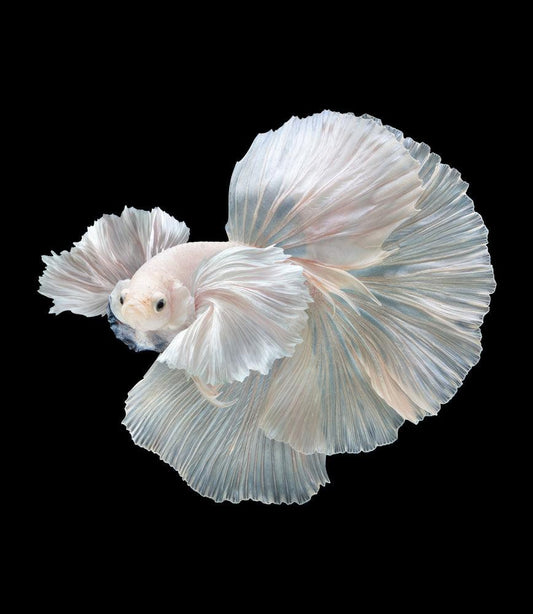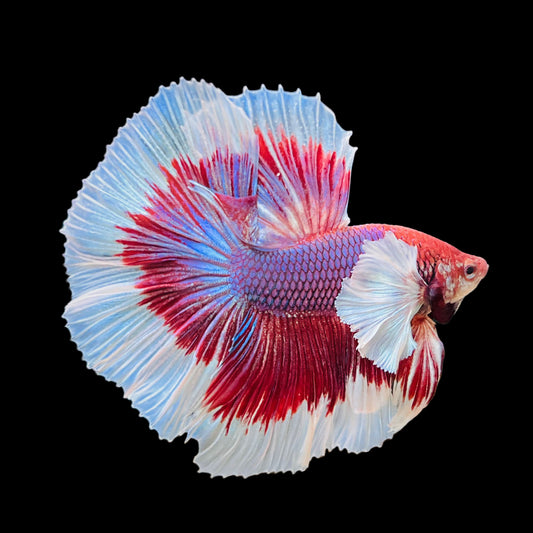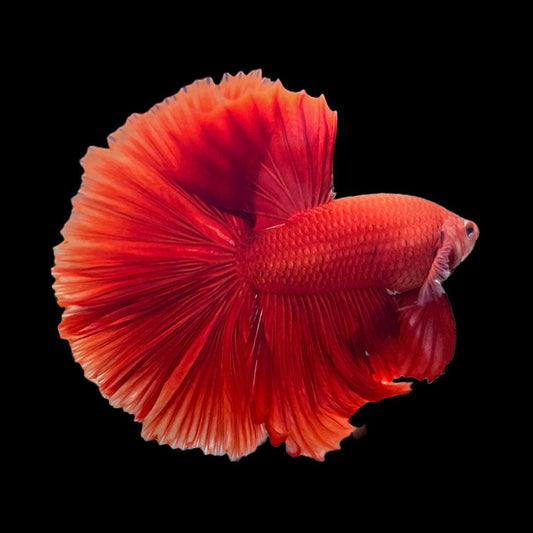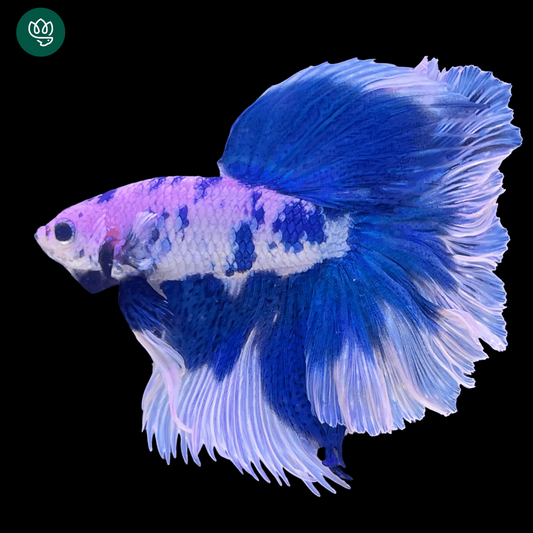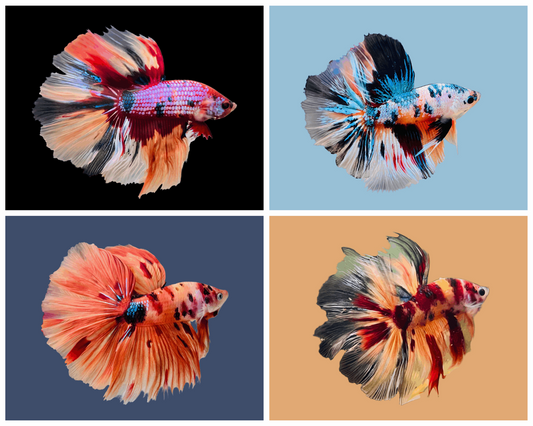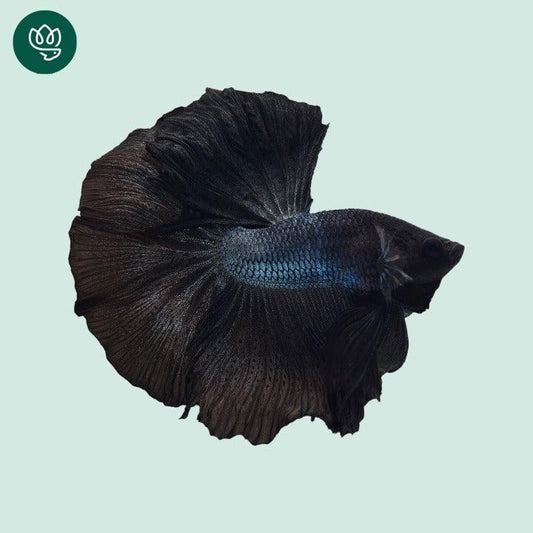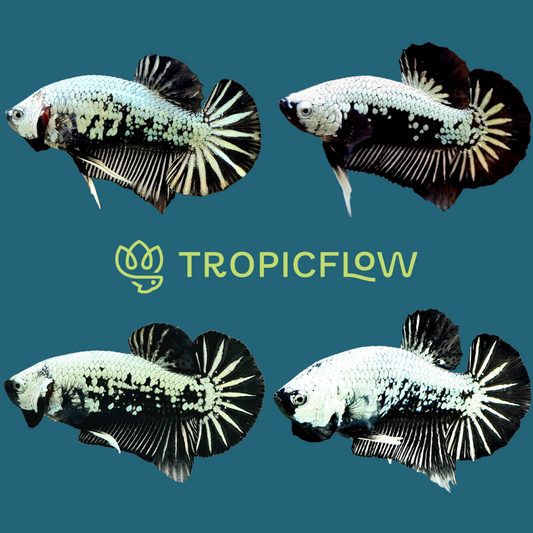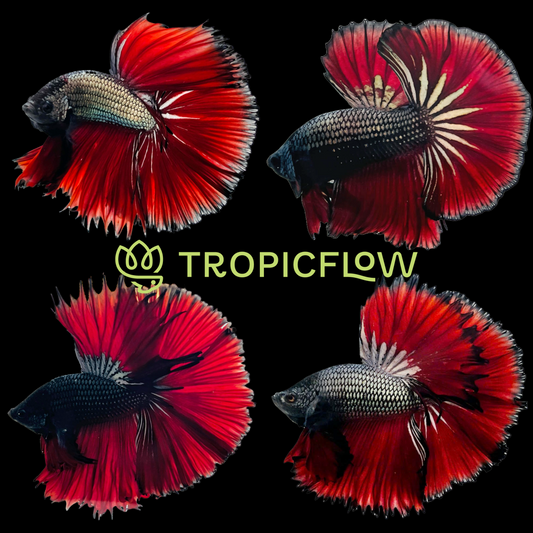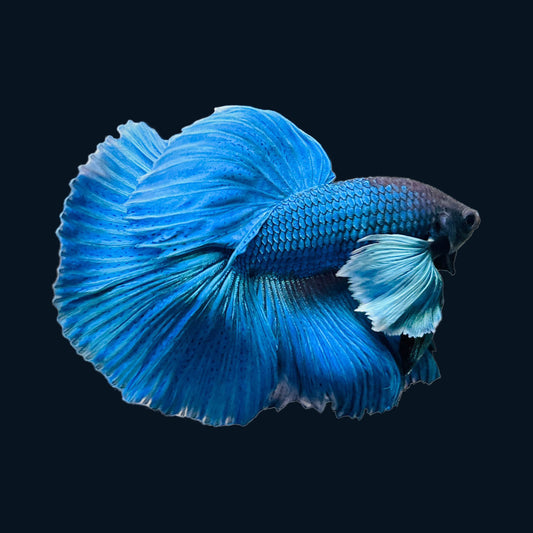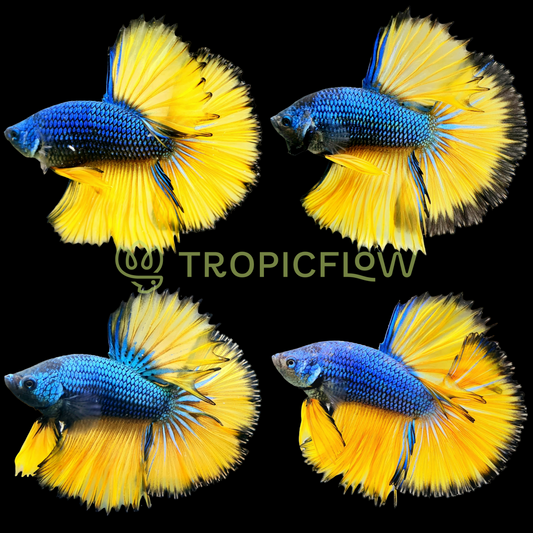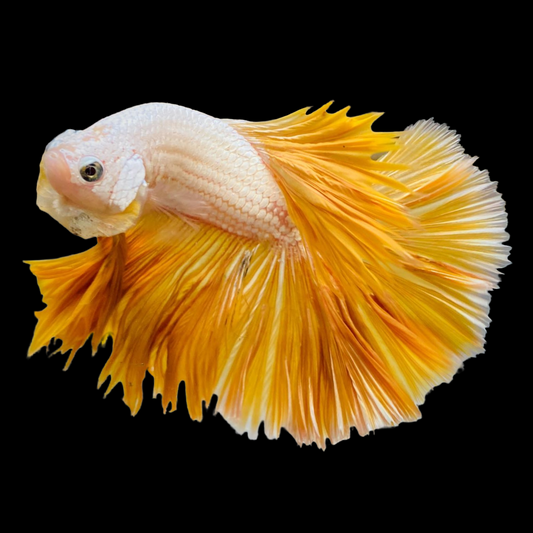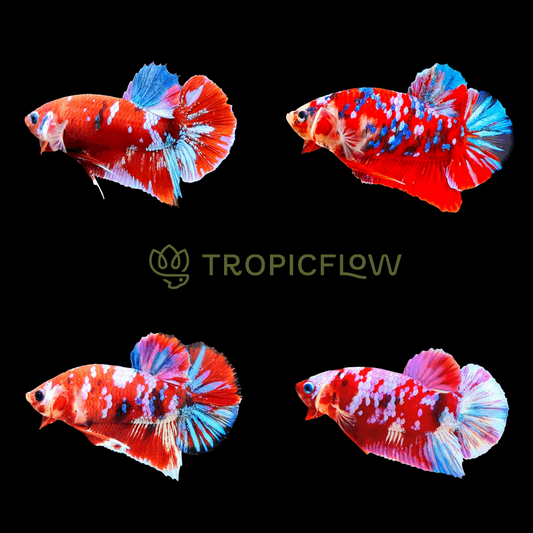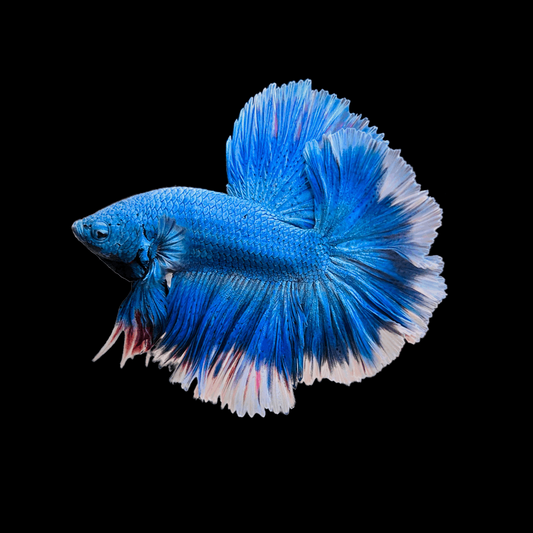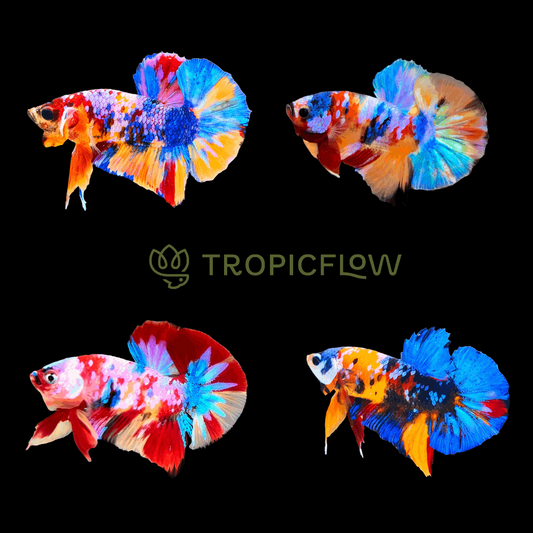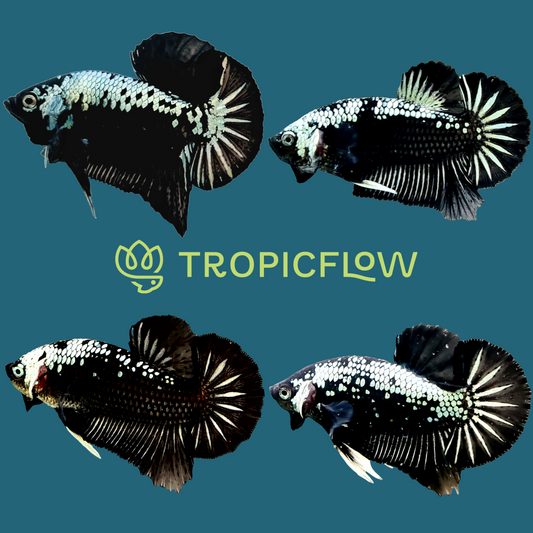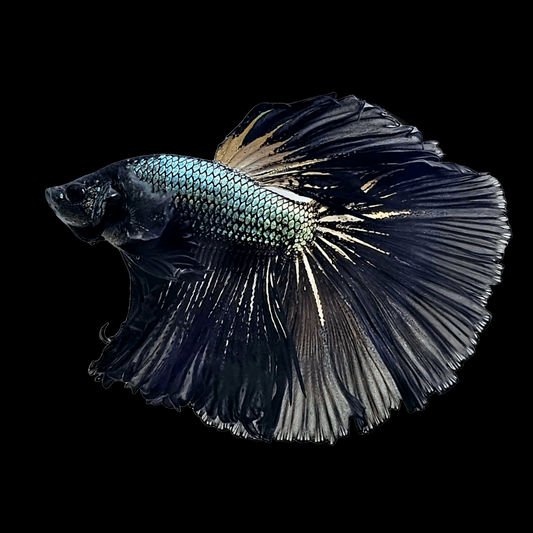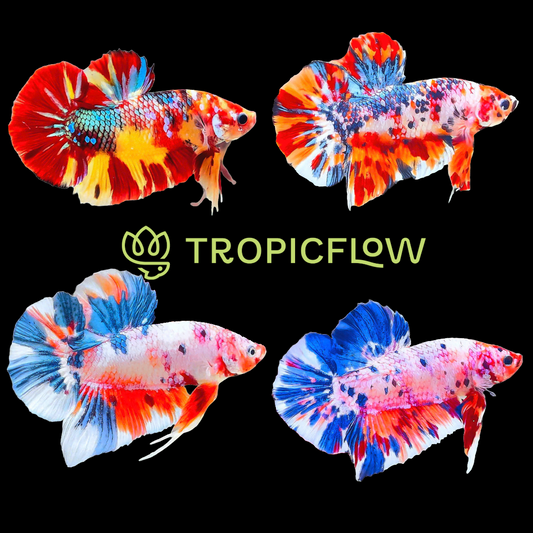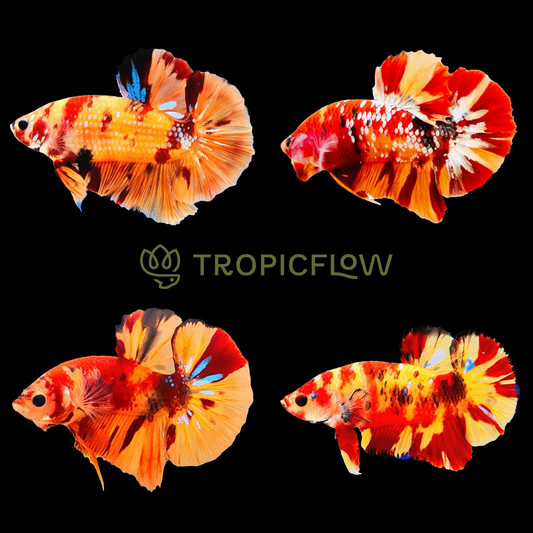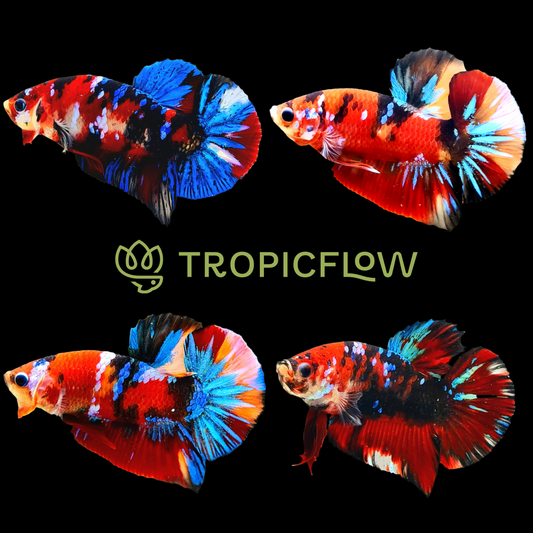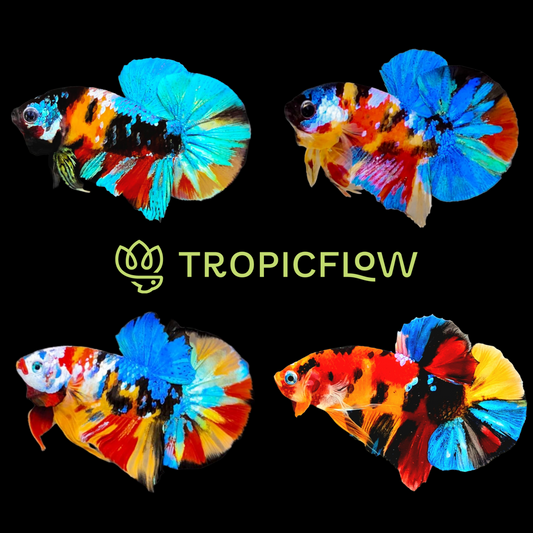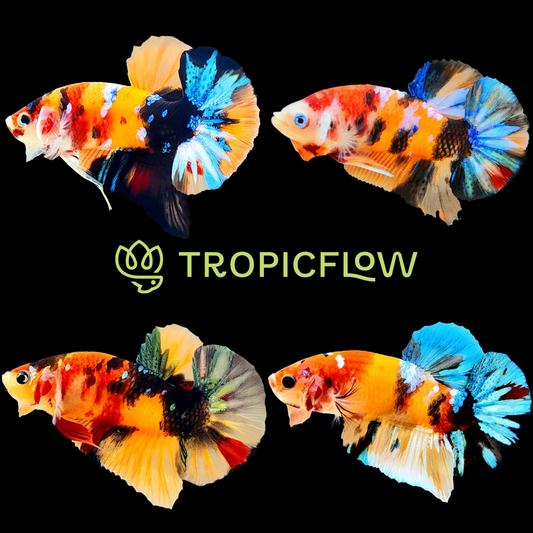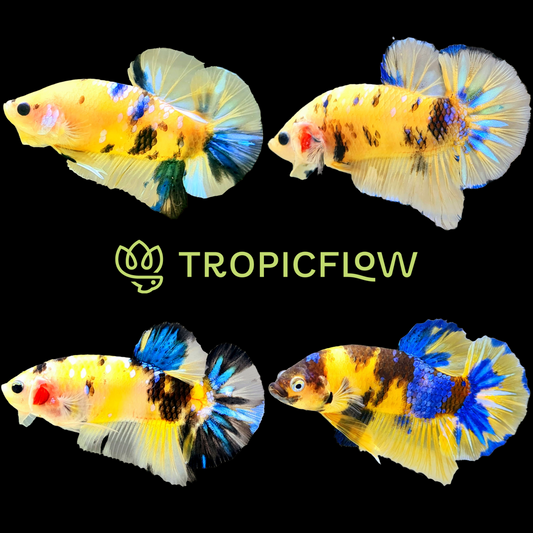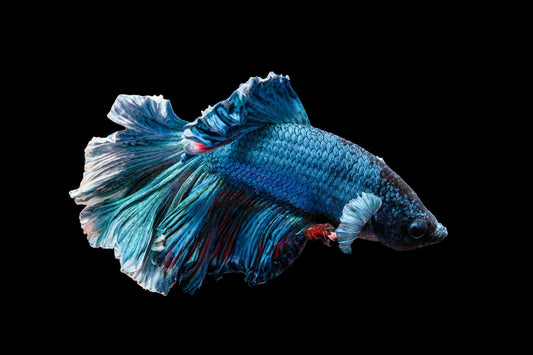Betta Fish Varieties: Choose Your Aquatic Companion
Explore our curated selection of Betta fish, each variety a testament to the beauty and diversity of these aquatic marvels. The Betta fish, also known as Siamese fighting fish, are renowned for their vibrant colors and dramatic finnage, making them a coveted addition to any aquarium.
- Halfmoon Betta: Marvel at the spectacular splendor of the Halfmoon Betta, its tail unfurled like a graceful banner. These Betta fish are a symphony of color, with each fin a canvas displaying vivid hues.
- Multicolor Betta: Discover the ever-changing beauty of Multicolor Betta fish. Their dynamic color patterns ensure that no two fish are identical, offering a unique living piece of art for viewing.
- Giant Betta Fish: Step into the grand world of Giant Betta fish. Their imposing size and gentle demeanor make them a fascinating species to observe and a favorite among Betta aficionados.
- Koi Galaxy Betta: Gaze upon the Koi Galaxy Betta, where the mystique of the night sky meets the intricate patterns of koi. These Bettas bring the allure of a starlit night to the tranquil waters of your tank.
- Dragon Betta: Behold the Dragon Betta, with its scale-like shimmer and bold colors that command attention. These Bettas exude strength and elegance, reminiscent of mythical dragons.
- Exotic Betta: Venture into the realm of Exotic Betta fish, where rarity and extraordinary patterns come together. For those seeking the pinnacle of Betta fish uniqueness, this category promises specimens that defy the ordinary.
With our selection of Betta fish, you’re not just purchasing a pet; you’re choosing a living, breathing piece of art that will bring wonder and tranquility to your home. Dive into the vibrant world of Betta fish and let these majestic creatures captivate your heart.
Best-Selling Betta Fish: Find Your Perfect Aquatic Match
Betta fish are treasured for their striking appearance, individual personalities, and care requirements. Here's a comparative look at our best-selling Betta fish to help you select the perfect aquatic partner.
- Super White Dumbo Ear Halfmoon Male Betta: Celebrated for its angelic white fins and tranquil demeanor, this Betta is a peaceful tank inhabitant. However, its light color may require more maintenance to keep its environment pristine, as debris is more noticeable.
- Super Red Halfmoon Male Betta: A vibrant addition to any tank with its bold red color, this Betta's lively movements are enchanting. The intense color may fade if not cared for with a proper diet and clean habitat.
- Blue Marble Dot Plakat Male Betta: This variety is adored for its resilient nature and shorter fins, which make it less prone to fin damage. Its marbled coat is visually stunning, though it can vary significantly between individuals, so each fish is a surprise.
- Snow Dragon Plakat Male Betta: Highly sought after, this Betta's rarity can make it a collector's item. Its distinct patterning is a delight, but the pale color can be susceptible to stress stripes if the fish is not kept in optimal conditions.
- Blue Butterfly Halfmoon Male Betta: Known for its expansive fins and serene blue shades, it requires a spacious tank to prevent fin tearing. It's a docile creature but can be shy, needing hiding spots within the tank.
- Red Dragon Halfmoon Male Betta: This Betta boasts a commanding presence with a bold color pattern. However, it may display territorial behavior and should be housed alone or with non-aggressive tank mates.
Each Betta fish brings its own set of care requirements and personality traits. Whether you're drawn to the angelic beauty of the Super White Dumbo or the fiery spirit of the Super Red Halfmoon, ensure you're prepared to meet their needs. By understanding the unique attributes of each Betta fish, you're one step closer to finding your ideal match that will thrive under your care and attention.
-
Super White Dumbo Ear Halfmoon Male Betta Fish
Regular price $30.00 USDRegular priceUnit price per$35.00 USDSale price $30.00 USDSale -

Multicolor Halfmoon Male Betta Fish | High Grade | Order Directly From Farm| You Pick Fish |
Regular price From $39.99 USDRegular priceUnit price per$0.00 USDSale price From $39.99 USDSold out -
Dumbo Lavender Halfmoon Male Betta Fish
Regular price $30.00 USDRegular priceUnit price per$40.00 USDSale price $30.00 USDSale -
Multicolor Plakat Male Betta Fish |Show Grade| You Pick Fish
Regular price From $79.99 USDRegular priceUnit price per$0.00 USDSale price From $79.99 USD -
Super Red Halfmoon Male Betta Fish
Regular price $30.00 USDRegular priceUnit price per$0.00 USDSale price $30.00 USD -
Blue Marble Dot Halfmoon Male Betta Fish | Grower Pick
Regular price $40.00 USDRegular priceUnit price per$40.00 USDSale price $40.00 USD -
Mix Galaxy Halfmoon Male Betta Fish High Grade | Buy 4 Get 1 Free | Mystery Betta
Regular price From $25.00 USDRegular priceUnit price per$0.00 USDSale price From $25.00 USD -
Super Black Halfmoon Male Betta Fish
Regular price $35.00 USDRegular priceUnit price per$0.00 USDSale price $35.00 USD -
Black Dragon Plakat Male Betta Fish
Regular price $35.00 USDRegular priceUnit price per -
Red Copper Halfmoon Male Betta Fish
Regular price $30.00 USDRegular priceUnit price per$40.00 USDSale price $30.00 USDSale -
Royal Blue Dumbo Halfmoon Male Betta Fish
Regular price $30.00 USDRegular priceUnit price per$40.00 USDSale price $30.00 USDSale -
King Giant Plakat Male Betta Fish | You Pick Fish | High Grade
Regular price From $69.99 USDRegular priceUnit price per$0.00 USDSale price From $69.99 USD -
Mustard Gas Blue Halfmoon Male Betta Fish
Regular price $35.00 USDRegular priceUnit price per$0.00 USDSale price $35.00 USDSold out -
Blue Marble Dot Plakat Male Betta Fish | Mystery Betta
Regular price $25.00 USDRegular priceUnit price per$35.00 USDSale price $25.00 USDSold out -
Yellow Dragon Halfmoon Male Betta Fish
Regular price $35.00 USDRegular priceUnit price per$0.00 USDSale price $35.00 USDSold out -
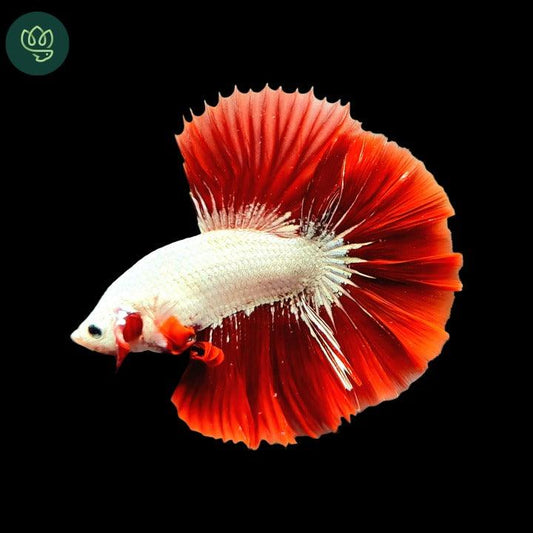 Sold out
Sold outRed Dragon Halfmoon Male Betta Fish
Regular price $30.00 USDRegular priceUnit price per$35.00 USDSale price $30.00 USDSold out -
Blue Marble Dot Halfmoon Male Betta Fish | Order Directly From Farm | You Pick Fish
Regular price From $30.00 USDRegular priceUnit price per$40.00 USDSale price From $30.00 USDSale -
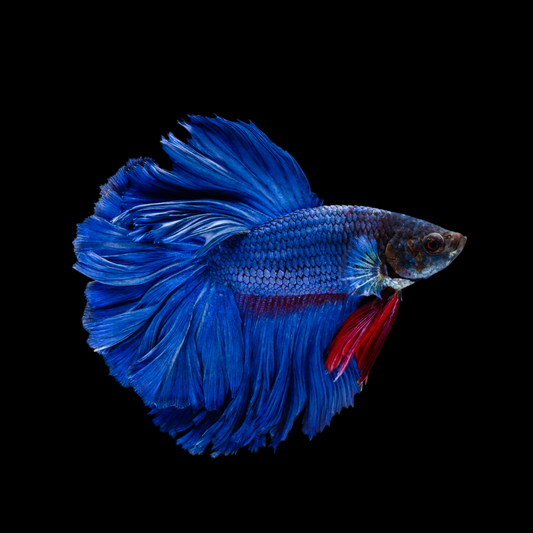 Sold out
Sold outSuper Blue Halfmoon Male Betta Fish
Regular price $30.00 USDRegular priceUnit price per$35.00 USDSale price $30.00 USDSold out -
Koi Red Galaxy Male Betta Fish High Grade | Buy 4 Get 1 Free | Mystery Betta
Regular price From $30.00 USDRegular priceUnit price per$0.00 USDSale price From $30.00 USD -
Dumbo Blue Butterfly Halfmoon Male Betta Fish
Regular price $30.00 USDRegular priceUnit price per$40.00 USDSale price $30.00 USDSale -
Multicolor Plakat Male Betta Fish High Grade | Buy 4 Get 1 Free | Mystery Betta
Regular price From $35.00 USDRegular priceUnit price per -
Multicolor Halfmoon Male Betta Fish | Order Directly From Farm | You Pick Fish
Regular price From $39.99 USDRegular priceUnit price per$49.99 USDSale price From $39.99 USDSold out -
Black Samurai Plakat Male Betta Fish | Mystery Betta
Regular price $35.00 USDRegular priceUnit price per$0.00 USDSale price $35.00 USD -
Black Dragon Halfmoon Male Betta Fish
Regular price $30.00 USDRegular priceUnit price per$40.00 USDSale price $30.00 USDSold out
Plakat Betta Collection: Vibrant Warriors of the Water
The Active Enthusiast’s Choice: Plakat Bettas are the pugilists of the Betta world, embodying a zest for life with their active swimming and shorter, robust fins. If you're looking for a Betta that exhibits more vigorous behavior and a dynamic presence in the tank, the Plakat Betta is an exceptional choice.
Durability and Ease of Care: Unlike the delicate fins of Halfmoon Bettas, which are prone to tearing and fin rot, Plakat Bettas have sturdy fins that make them less susceptible to common Betta ailments. They are the ideal selection for beginners or those who prefer a low-maintenance aquatic pet.
Space-Efficient: If your aquarium space is limited, Plakat Bettas are more adaptable to smaller environments compared to larger varieties like the Giant Betta Fish. Their compact size does not dampen their spirit, making them a great fit for urban dwellers with cozier living spaces.
Standout Visual Appeal: While Multicolor, Koi Galaxy, Dragon, and Exotic Bettas are known for their striking colors and patterns, Plakat Bettas offer a unique visual charm with their muscular build and vibrant hues, making them stand out in their own right.
Temperament and Compatibility: For those who appreciate the feisty side of Bettas, Plakats offer a lively personality. They may be more aggressive than some types, which can be a factor to consider if you're planning a community tank. However, this spirited nature is part of their allure and can provide endless entertainment.
Versatility: Plakat Bettas are versatile and can thrive in various water conditions, unlike some of the more sensitive strains like the Exotic Betta, which may require more precise water parameters.
In conclusion, Plakat Bettas are a superb choice for those who seek a combination of resilience, activity, and adaptability. They deliver the breathtaking beauty associated with Bettas while also being hardy warriors, capable of thriving in a variety of settings. Whether you're a seasoned aquarist or new to the hobby, a Plakat Betta could be the perfect new addition to your aquatic family.
-
Multicolor Plakat Male Betta Fish |Show Grade| You Pick Fish
Regular price From $79.99 USDRegular priceUnit price per$0.00 USDSale price From $79.99 USD -
King Giant Plakat Male Betta Fish | You Pick Fish | High Grade
Regular price From $69.99 USDRegular priceUnit price per$0.00 USDSale price From $69.99 USD -
Multicolor King Giant Plakat Male Betta Fish | Mystery Betta
Regular price From $60.00 USDRegular priceUnit price per$0.00 USDSale price From $60.00 USD -
Multicolor Plakat Male Betta Fish High Grade | Buy 4 Get 1 Free | Mystery Betta
Regular price From $35.00 USDRegular priceUnit price per -
Nemo Galaxy Male Betta Fish High Grade | Buy 4 Get 1 Free | Mystery Betta
Regular price From $30.00 USDRegular priceUnit price per -
Koi Red Galaxy Black Base Male Betta Fish | Buy 4 Get 1 Free | Mystery Betta
Regular price From $35.00 USDRegular priceUnit price per$30.00 USDSale price From $35.00 USD -
Koi Red Galaxy Male Betta Fish High Grade | Buy 4 Get 1 Free | Mystery Betta
Regular price From $30.00 USDRegular priceUnit price per$0.00 USDSale price From $30.00 USD -
Multicolor Black Base Plakat Male Betta Fish | High Grade | Mystery Betta
Regular price From $35.00 USDRegular priceUnit price per -
Nemo Galaxy Black Base Male Betta Fish | Mid Grade | Mystery Betta
Regular price From $35.00 USDRegular priceUnit price per -
Koi Yellow Galaxy Male Plakat Betta Fish | Mid Grade | Mystery Betta
Regular price From $35.00 USDRegular priceUnit price per$0.00 USDSale price From $35.00 USD -
Black Dragon Plakat Male Betta Fish
Regular price $35.00 USDRegular priceUnit price per -
Golden Star Dust Galaxy Plakat Male Betta Fish | Super Rare | You Pick Fish
Regular price $99.00 USDRegular priceUnit price per -
Blue Marble Dot Plakat Male Betta Fish | Mystery Betta
Regular price $25.00 USDRegular priceUnit price per$35.00 USDSale price $25.00 USDSold out -
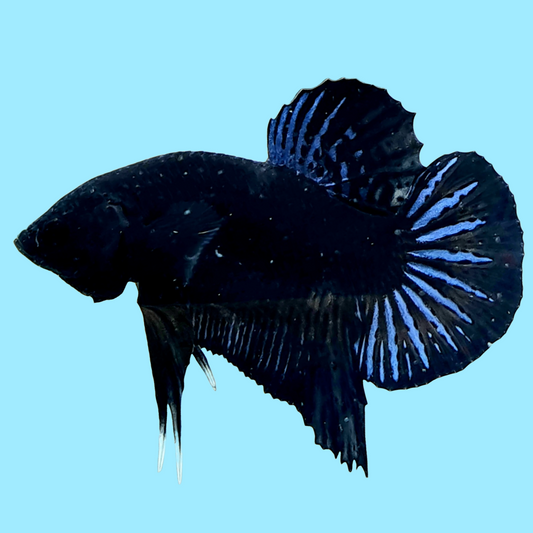 Sold out
Sold outSuper Black Plakat Male Betta Fish
Regular price $30.00 USDRegular priceUnit price per -
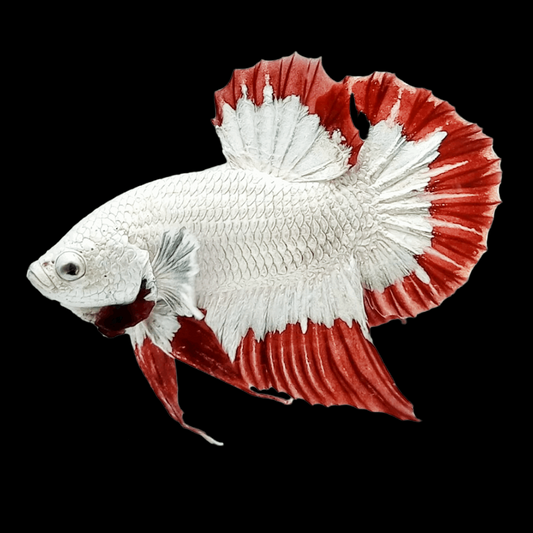 Sold out
Sold outSnow Dragon Plakat Male Betta Fish
Regular price $30.00 USDRegular priceUnit price per -
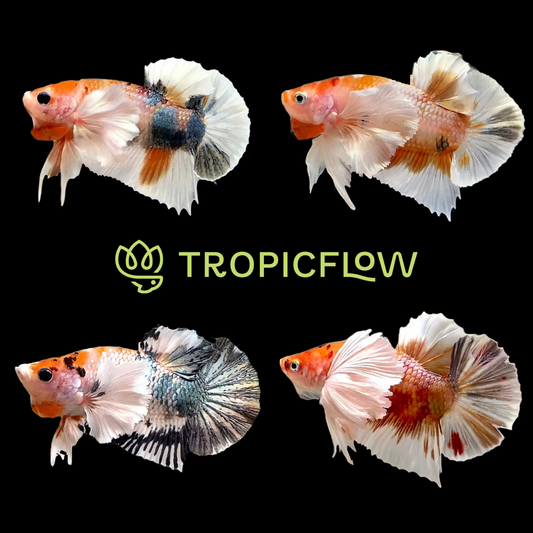 Sold out
Sold outDumbo Koi Plakat Male Betta Fish
Regular price $35.00 USDRegular priceUnit price per
Why Choose Tropicflow: Your Assurance of Aquatic Excellence
When you choose Tropicflow, you're not just buying a Betta fish; you're investing in a full-service experience that prioritizes the health and happiness of your aquatic pet. From our fish to your front door, every step is imbued with our promise of excellence and care.
-

100% Live Arrival Guarantee
At Tropicflow, our top priority is to ensure that our customers are completely satisfied with their purchases. We understand that receiving a shipment with dead livestock or plants can be a frustrating experience, which is why we offer our 100% Live Arrival Guarantee. Rest assured, we are committed to making things right and ensuring that you are happy with your purchase.
-

High Quality Fish
At Tropicflow, we take the health and happiness of our fish seriously. That's why we only send out the best of the best - healthy fish with shiny, vibrant colors and beautifully wide tails. And before they make their way to your aquarium, we give them the royal treatment: two full days of quarantine to ensure they're in top shape and ready for their new home.
-

Flat Shipping Rates $25
Tropicflow offers UPS 2-day air flat rate shipping for $25, allowing you to consolidate multiple fish in a single order. This cost-effective shipping option ensures swift delivery while giving you the freedom to add as many fish as you desire to your order.
Customer Review
FAQ
FAQs Betta fish
How much does a betta fish cost?
The price of a Betta fish can vary widely depending on the type, coloration, and finnage quality. Common Betta fish can cost as little as $2-$10, while specialized breeds like Halfmoon or Plakat may range from $20 to $100 or more for show-quality specimens.
What are the best water conditions for betta fish?
Betta fish thrive in warm water, with ideal temperatures ranging from 76 to 81 degrees Fahrenheit. The water should be slightly acidic to neutral (pH 6.5-7.5) with low to moderate hardness, and it's crucial to keep ammonia and nitrite levels at zero through regular maintenance.
How to set up a betta fish tank?
A minimum tank size of 5 gallons is recommended for a Betta. Include a heater and filter with gentle flow, substrate, plants, and hiding spots. Condition the water to remove chloramines and chlorine, cycle the tank to establish beneficial bacteria, and maintain a consistent temperature.
How long should you wait to put betta fish in a new tank?
After setting up a new tank, it's important to wait until the nitrogen cycle is complete before introducing a Betta fish. This process typically takes 4-6 weeks. Use water testing kits to ensure levels of ammonia, nitrite, and nitrate are appropriate.
How much to feed betta fish?
Feed Betta fish 2-3 pellets of high-quality food once or twice daily. Portion size should be small, roughly the size of their eye. Overfeeding can lead to health issues and water quality problems. Remove any uneaten food to prevent it from decaying in the tank.
How often do you feed betta fish?
Feed your betta fish once or twice daily. Consistency is vital, so choose a feeding schedule that you can maintain regularly, and try to feed at the exact times each day to establish a routine.
What fish can live with bettas?
Bettas can coexist with peaceful, non-nipping fish such as neon tetras, harlequin rasboras, or corydoras catfish. Avoid housing them with aggressive fish or those with similar finnage that could be mistaken for another betta, which could provoke fighting.
How to clean the betta fish tank?
Perform weekly water changes of 20-25%, using a siphon to remove debris from the substrate. Replace with treated water at the same temperature to minimize stress. Monthly, clean the tank sides, decorations, and filter components, taking care not to disrupt beneficial bacteria.
How do Betta fish sleep?
Betta fish sleep by resting on the bottom of the tank, leaves, or in a betta bed near the surface. They prefer to sleep in darker conditions and may lie still for several hours. It's normal for bettas to choose a regular spot to sleep.
Why do betta fish fight?
Betta fish are territorial by nature, especially males, and will fight to defend their space. This aggression is typically directed towards other bettas to establish dominance, so male bettas should be housed separately.
Why is my betta fish not eating?
A betta might not eat due to stress, poor water quality, illness, or if the food offered is not to their liking. Ensure optimal tank conditions and try varying the diet. If the issue persists, consult a vet, as it could be a sign of disease.
Why is my betta fish not moving?
Bettas may become inactive due to stress, poor water conditions, sickness, or old age. Verify water parameters are within the ideal range and observe for other symptoms to rule out illness. If water conditions are acceptable and no signs of disease, the Betta may rest.
Why is my betta fish turning white?
A betta turning white could indicate a fungal infection, stress, or columnaris disease. Ensure water quality is high; if the condition worsens, seek advice from an aquatic veterinarian for specific treatments.
Best water for betta fish?
The best water for betta fish is dechlorinated tap water that matches their natural conditions: a temperature of 76-81°F, a pH of 6.5-7.5, and soft to moderately hard. Use a water conditioner to remove harmful chemicals.
How do you entertain a betta fish?
Entertain a betta by providing a stimulating environment with plants, caves, and floating toys. Interactive play with a mirror or pointing a laser for short periods can also engage them. Rotate decorations during water changes to renew their interest.
Are betta fish bright?
Yes, betta fish are considered intelligent for fish. They can recognize their owners, respond to training such as following your finger or jumping through hoops, and require mental stimulation to stay active and healthy.
Why do betta fish make bubble nests?
Betta fish create bubble nests as part of their breeding behavior, driven by instinct even without the presence of a female. It indicates good health and that your Betta is ready to mate, as they will lay their eggs in these nests.
How to tell if a betta fish is male or female?
Male bettas typically have longer, more vibrant fins and brighter colors, while females are generally smaller, with shorter fins and less intense coloration. Females also have an ovipositor, a small white spot near the ventral fins.
How to tell if a betta fish is happy?
A happy betta is active, has a good appetite, and displays bright colors. You may also see them making bubble nests. They should respond to your presence and show curiosity about their environment.
How do you tell if Betta is stressed?
Signs of a stressed betta include clamped fins, fading colors, lethargy, hiding, loss of appetite, and darting rapidly. Stress can be caused by poor water conditions, inappropriate tank mates, or insufficient hiding spaces.
Why is my betta fish swimming sideways?
Sideways swimming in betta fish is often a sign of swim bladder disorder, which can be caused by overfeeding, constipation, or an infection. Fasting your Betta for a day or two and then feeding a cooked, peeled pea can help with constipation. If the condition persists, seek veterinary care.
How long do betta fish live?
Betta fish typically live for 2 to 5 years with proper care, which includes a nutritious diet, clean and warm water, and a stress-free environment. Lifespan can vary based on genetics and quality of life.
How long can a Betta fish live without a filter?
Betta fish can survive without a filter if the water is changed frequently to prevent toxin buildup. However, a filter is recommended to maintain water quality and provide a healthy environment for long-term health.
Why do betta fish fight?
Betta fish, particularly males, are naturally territorial and will fight to defend their space. They are prone to aggression towards others of their species as a display of dominance or defense.
How many babies do betta fish have?
A female betta can lay anywhere from 20 to several hundred eggs during a single breeding. Not all will be fertilized or survive adulthood, and the fry requires specialized care to reach maturity.
What can fish eat besides fish food?
Besides high-quality betta pellets or flakes, bettas can eat frozen or live foods such as brine shrimp, daphnia, or bloodworms. These should be given as treats and not replaced with a balanced betta-specific diet.







